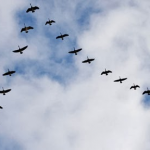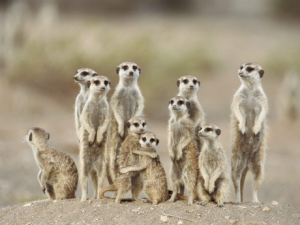 The last of the ponds where I live froze over this week. The bitter cold weather has made it a struggle for the geese to find food, and the few remaining flocks of geese can be seen overhead, heading for warmer regions. The sight of the birds streaming across the sky, in V-formation reminds me of the often quoted parable, “The Wisdom of Geese”. The way the geese fly in a pattern to conserve energy and use the uplift from the birds in the front of the V suggests lessons to be learned by people who work together in teams. The “wisdom” to be gained from the flight patterns of geese is that teams who share a common goal and a sense of community will arrive at their intended destination more efficiently, because (like the geese) they accept help of another, and simultaneously offer benefit to their peers. As a goose falls out of the V-formation, it suddenly feels drag and resistance and quickly moves back into formation to take advantage of the aerodynamic properties of the V-pattern. What are the big lessons here? If you have as much sense as a goose, you will stay in formation with those headed where the team wants to go. And, just like geese, a well-functioning team will stand by each other when the going gets tough.
The last of the ponds where I live froze over this week. The bitter cold weather has made it a struggle for the geese to find food, and the few remaining flocks of geese can be seen overhead, heading for warmer regions. The sight of the birds streaming across the sky, in V-formation reminds me of the often quoted parable, “The Wisdom of Geese”. The way the geese fly in a pattern to conserve energy and use the uplift from the birds in the front of the V suggests lessons to be learned by people who work together in teams. The “wisdom” to be gained from the flight patterns of geese is that teams who share a common goal and a sense of community will arrive at their intended destination more efficiently, because (like the geese) they accept help of another, and simultaneously offer benefit to their peers. As a goose falls out of the V-formation, it suddenly feels drag and resistance and quickly moves back into formation to take advantage of the aerodynamic properties of the V-pattern. What are the big lessons here? If you have as much sense as a goose, you will stay in formation with those headed where the team wants to go. And, just like geese, a well-functioning team will stand by each other when the going gets tough.
Because I am working on helping school districts to design ways to engage teachers in leadership roles, I wondered how the flying geese analogies apply to teacher leadership. The “wisdom of geese” is a lovely thing to think about, because the geese often fly long distances in harsh conditions and collectively arrive as a flock at their far-off and warm destination. Some of the schools I have been working with are facing tough challenges, and introducing teacher leadership roles could serve to help teams of teachers to work together to accomplish their goals over the long haul.
I looked to some more scientific accounts of migratory flight to help me think about the parallels between the birds’ behavior and team work in schools. A biologist writing for Scientific American reports that the V- flight formation of geese and other migratory birds is called an “echelon”. Geese travel in an echelon to conserve energy – the birds in the back take advantage of the up wash vortex fields created by the wings of the birds in front. A study published this week in Nature revealed that the northern bald ibis position themselves to fly behind and beside the bird in front and time their wing beats to catch uplifting eddies[1]. Good to know, the parable holds up so far. By working collectively with their colleagues, well trained teacher leaders provided with clear assignments, quality professional learning structures, and adequate organizational supports can strengthen the capacity of the full faculty to deliver effective instruction and improve student learning.
Scientists have also found that flying in this pattern facilitates orientation and communication among the birds. That concept works for school teams, also. An organized team with a leader at the front can be strategic about communication, planning, and keeping focused on the goal. Teacher leaders can be a great asset in sharing the district and school theory of action, designing and delivering professional learning, sharing data analyses, etc.
Interestingly, scientists assume that during brief feeding flights energy conservation is less important than orientation and avoiding collisions. When flying for long-distances as they migrate, optimizing their positions to conserve energy becomes more important. Hmm, what’s the metaphor for this hypothesis? Could it be that structured teaming practices help teachers to function on day-to-day interactions needed to get routine work done efficiently AND to accomplish larger goals such as improving their practice to accomplish gains in student learning?
Now, I am wondering about how the lead goose falls back, to be replaced by a fresher goose that has had the benefit of drafting off the front goose. Biologists have observed that lead birds in formations do change intermittently, but they don’t know why. Hypotheses about leader choice include variables such as age, experience, gender, condition and social status of the lead birds, but researchers have not figured out how to test this phenomenon yet. Applying this idea to school teams gets tricky. In schools, does the principal get tired or stressed out, and then one teacher leader steps up to the point position for a while? I am sure this does happen in schools from time to time, but a more likely situation is that all the teachers in leadership roles share data with the principal, facilitate teams, collaborate with teachers in their classrooms, demonstrate exemplary practices, collect and share resources, support strategic initiatives, and continuously contribute to an overall culture of learning.  All of these are instructional leadership responsibilities that serve to extend the capacity of the principal to lead all teachers to higher levels of capacity and improve learning. Maybe the metaphor of the “wise geese” doesn’t play out here. What might the flight pattern of a group of birds simultaneously creating updraft for the full flock, look like? A flying “S”? Maybe describing another species would work better. Evidently, Meerkats exhibit an entire repertoire of cooperative behaviors! Who knew? “Harmony among the Meerkats” will take a while to catch on in the field.
All of these are instructional leadership responsibilities that serve to extend the capacity of the principal to lead all teachers to higher levels of capacity and improve learning. Maybe the metaphor of the “wise geese” doesn’t play out here. What might the flight pattern of a group of birds simultaneously creating updraft for the full flock, look like? A flying “S”? Maybe describing another species would work better. Evidently, Meerkats exhibit an entire repertoire of cooperative behaviors! Who knew? “Harmony among the Meerkats” will take a while to catch on in the field.
Aguilar, E. (December 13, 2012). What Can school teams learn from geese? Edutopia. Retrieved from http://www.edutopia.org/blog/teacher-school-teams-geese-story-elena-aguilar
Khan, A. (January 15, 2014). Why do birds fly in a V? Endangered ibis reveals its amazing secret. Los Angeles Times: Science. Retrieved from http://www.latimes.com/science/sciencenow/la-sci-sn-birds-v-formation-flight-northern-bald-ibis-nature-bioinspired-20140115,0,3808246.story#ixzz2r2zIDlMW
Why do migratory birds fly in a V-formation? (October 1, 2007). Scientific American. Retrieved from http://www.scientificamerican.com/article.cfm?id=why-do-migratory-birds-fl
Ross-Gillespie, A. & Griffin, A. (June, 2007). Meerkats. Current Biology. Retrieved from www.cell.com/current-biology/fulltext/S0960-9822(07)01149-9
[1]
Portugal, S. et al. (January 16, 2014). Upwash exploitation and downwash avoidance by flap phasing in ibis formation flight. Nature. Retrieved from http://www.nature.com/nature/journal/v505/n7483/full/nature12939.html
